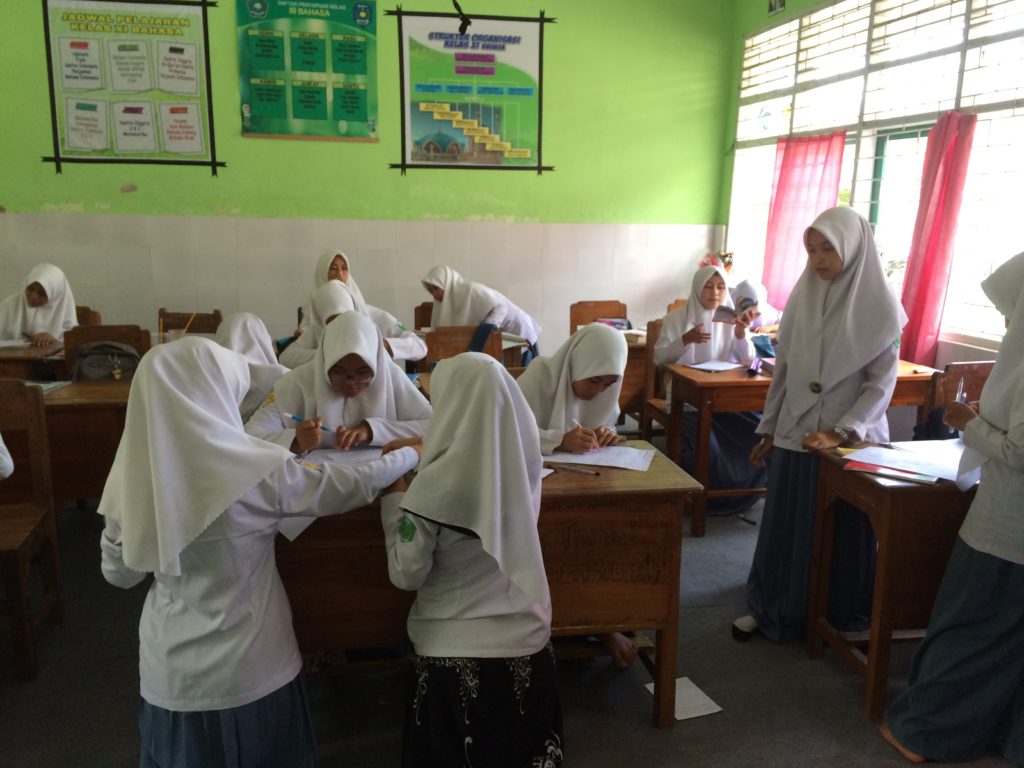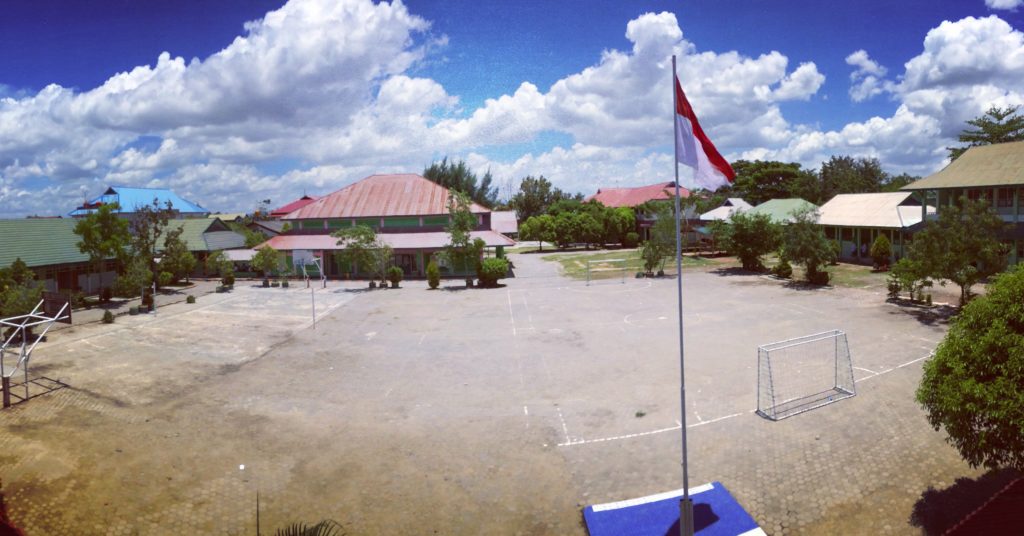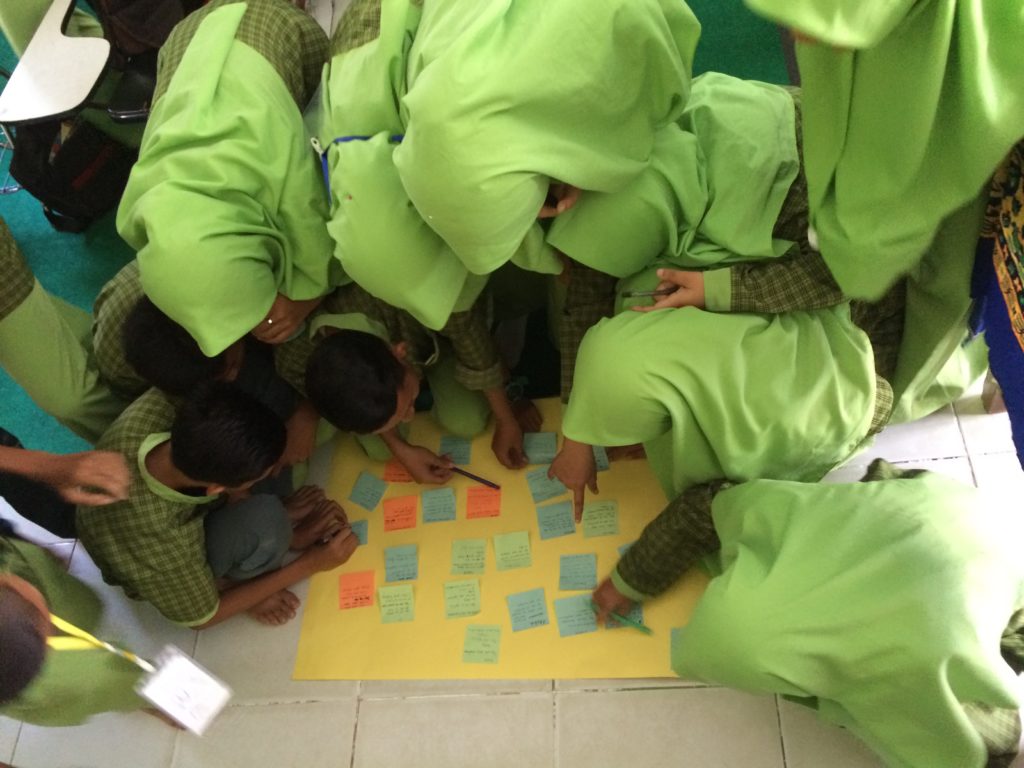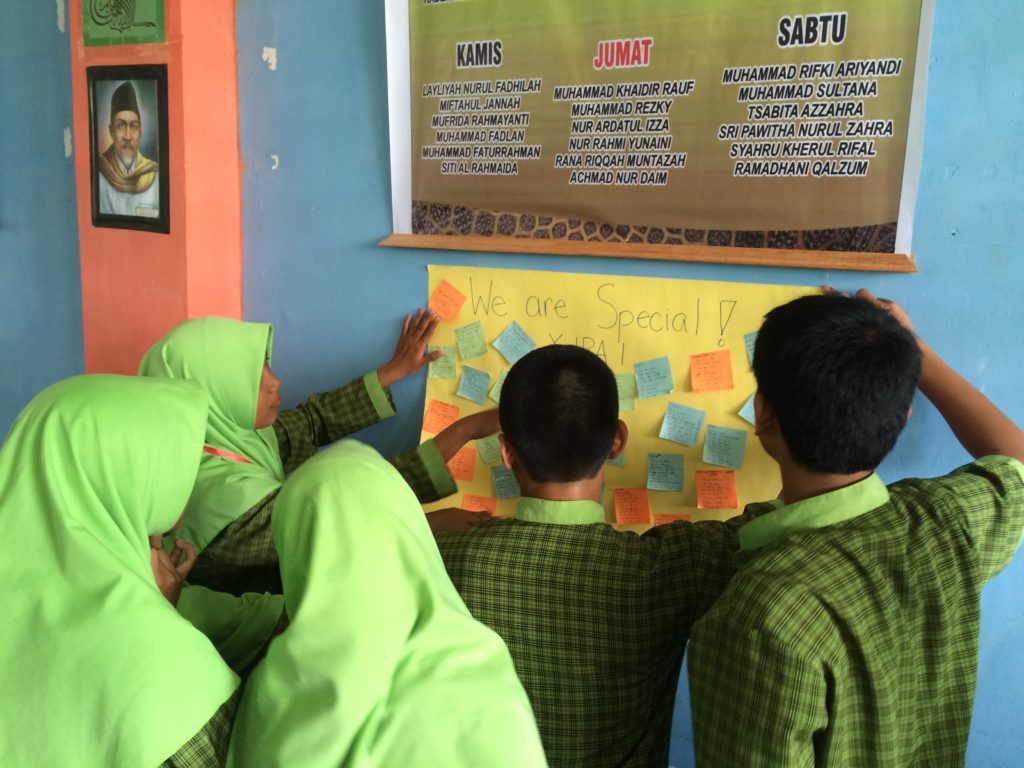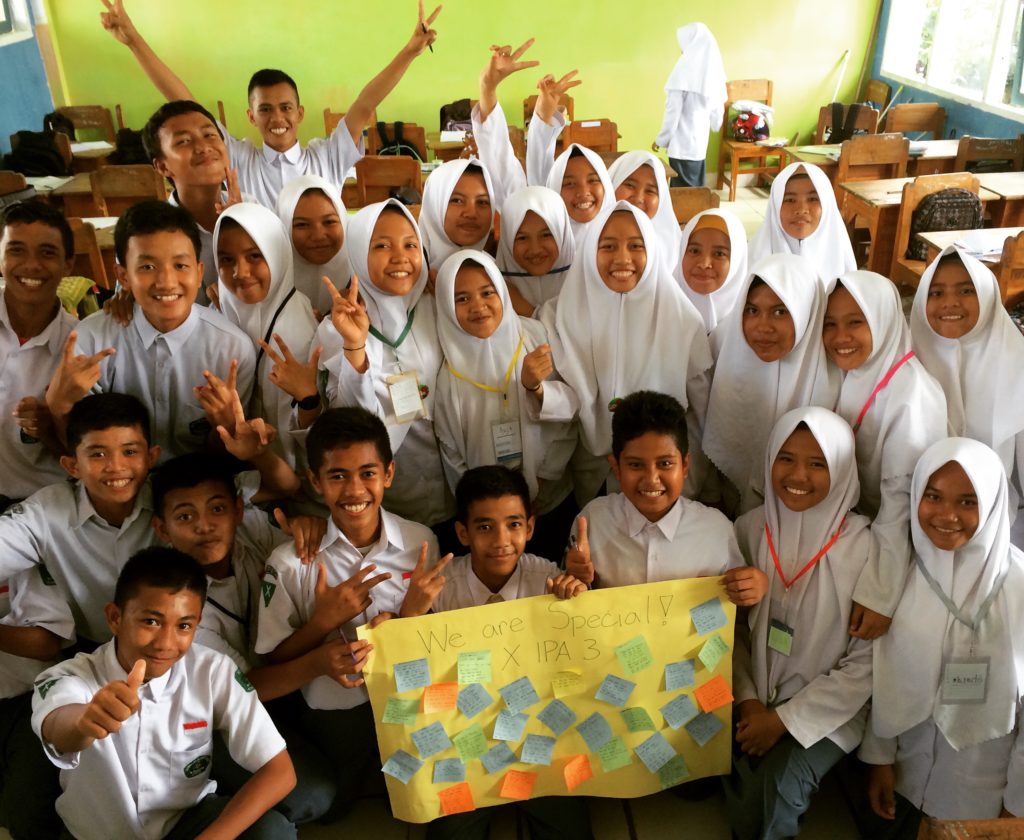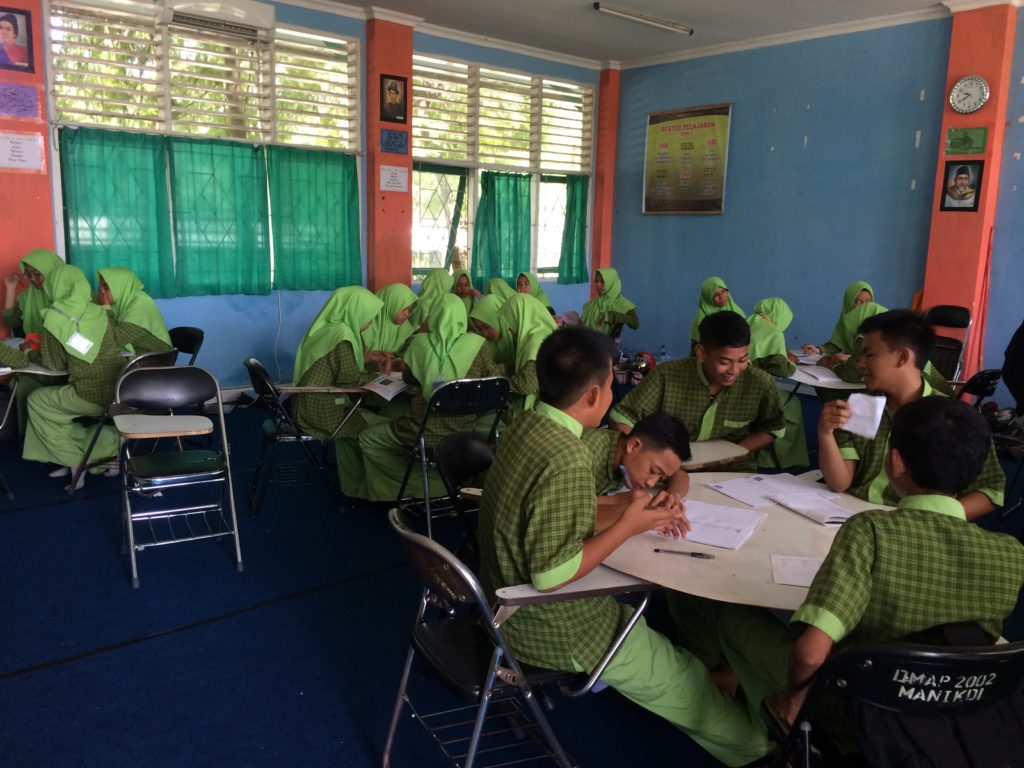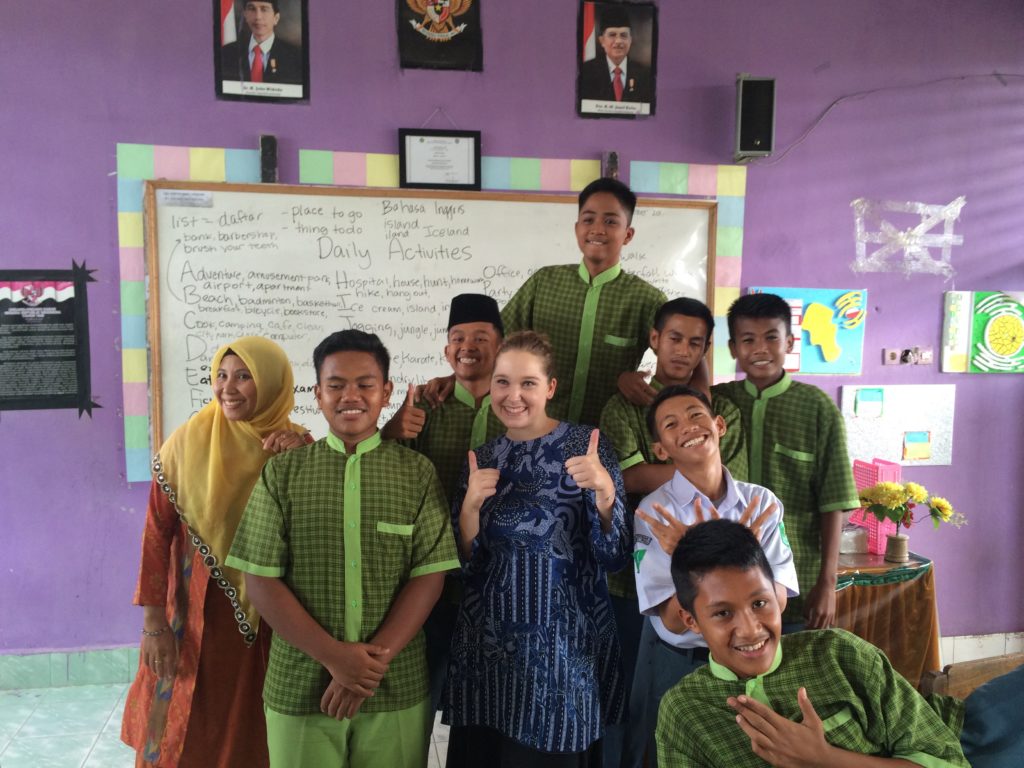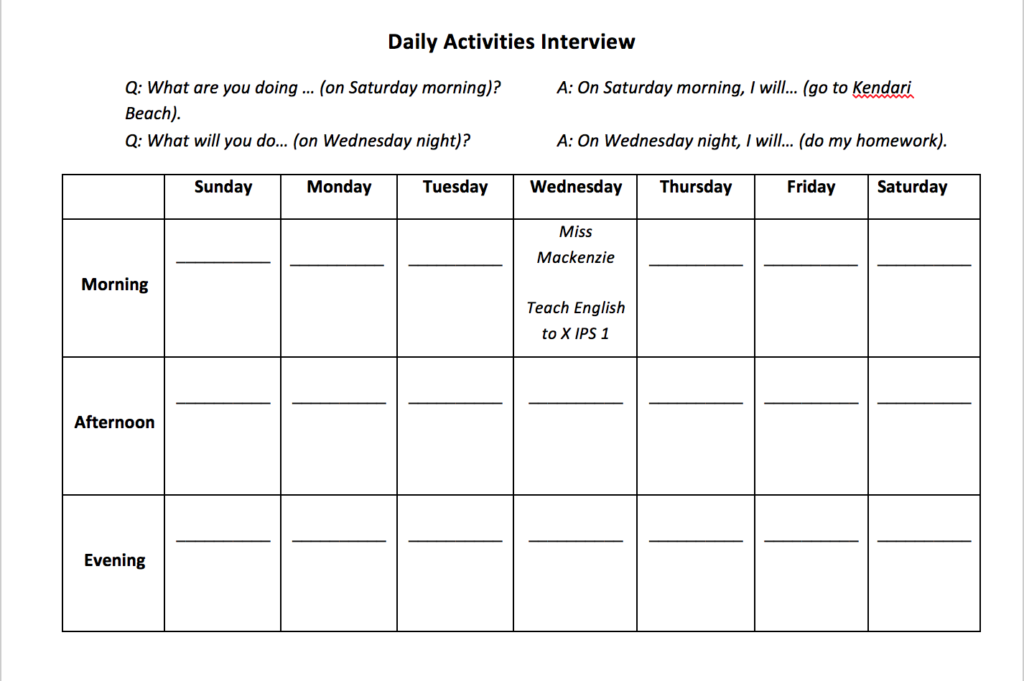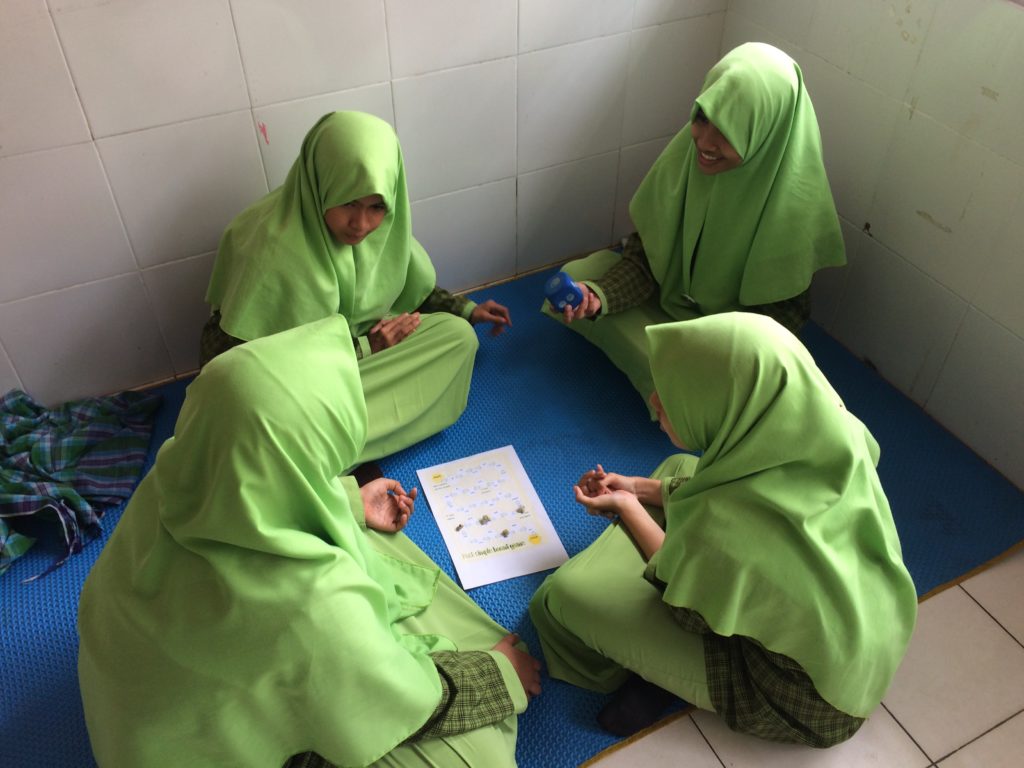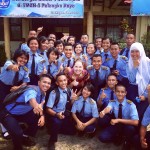First, I want to say thank you so much everyone who reached out after my last post (“Hey Mister”). Hearing from everyone, near and far, was so encouraging. It can be hard to live so far away from friends and family but having a virtual support system is a wonderful second best. I was also so glad to know that my post sparked conversations and thoughts about skin color, race, bules, and more… Please don’t let the conversations and thoughts stop – this is such an important topic.
But on to other subjects! I just completed my fourth week of teaching here in Kendari and things couldn’t be going better (in that regard). I teach 12 classes each week – all of them 90 minutes, except one which is a little over two hours. Each class has anywhere between 22-40 students (most around 30-35). I see each class 1x per week – which is a horrible, and impossible, way to learn a language. The lucky kids are the “Bahasa track” kids who essentially take English (and Japanese) as elective courses and so they get English twice a week.
All Indonesian high school students are split into “tracks” in high school. Schools generally offer 2+ tracks: Science, Social, Religion, Language, etc. SMAN 5 PKY only had science and social tracks, but MAN 1 KDI has all four of these. Vocational schools (SMKs) offer a whole different group: tourism, cooking, tailoring, etc. Students in Indonesian high schools take all of their classes with their “class.” So X IPA 1 (10th grade Science #1) is together the whole day, taking all of their classes together, while X IPS 1 (10th grade Social #1) sits in their room and takes all of their classes together. From what I understand, students choose their track but are tested into the higher or lower classes (IPA 1 is the “best” whereas IPA 4 is the “lowest” of the science track). Additionally, science students are considered the “smartest” and social students the “not as smart.” Religion and Bahasa tracks fall somewhere in between (and most people outside of those tracks wonder why you would choose that). I teach the entire 10th grade: X IPA 1, 2, 3, 4 (science); X IPS 1, 2, 3 (social); X Agama (Religion); and X Bahasa (Language). And two 11th Grade classes: XI Agama (Religion) and XI Bahasa (Language) –> but I see XI Bahasa twice a week.
My first and second weeks of teaching were difficult because I was expecting a higher level of English (something comparable to my students last year) but I wasn’t finding it. Giving instructions, praise, comments, greetings… anything in English was falling on deaf ears. Anything I said was greeted by… silence. Initially, I was really surprised. Seeing as this is a school that seems to run more efficiently and organized than my school last year, with teachers almost always going to class, and rules much more strict about students being in the classroom, I figured the English level would potentially be higher than my kids last year. At the very least it would be comparable, right?
Well… no. It took about two weeks for me to come to terms with it – but these kids’ English levels are low. And I mean LOW. Some classes don’t even know the word for “makan” (eat). Like, that has to be the most basic English word ever. Some students in my classes, and some 12th graders (who I don’t teach), call me “mister.” (Seriously?!) Sometimes, when I give them an activity, they ask if it should be completed in English or Bahasa Indonesian. Ummmmm… wild guess? What do you think you are supposed to do?!?!?!?!? This is ENGLISH class for crying out loud! Asking them to answer a simple question out loud is like asking them to give a speech in front of the whole school in French.
All this to say, teaching English is an uphill battle.
I’m generally at school for most of the day. Most days I teach 3 classes, which are separated by a 45 minute break, except Friday when they are back-to-back-to-back. I get to school at 8:30 or so. Teach from 8:45-10:15, break until 10:45, teach again from 10:45-12:15, break (to pray) until 1pm, and teach again from 1-2:30. Obviously, it’s Indonesia, so we usually don’t go to class until at least 5 minutes after the bell has rung, but more common 10-15 minutes late. (I’m slowly trying to change that with my coteachers…).
So considering all of these challenges, how do we spend those precious 90 minutes in the classroom?
It starts with lesson planning – this year, I am so much more prepared for my lessons. This in part has to do with a massive google drive collection of lesson plans from previous ETAs that Grace and I compiled and organized this summer. It makes it SO much easier to find lessons on the sometimes-obscure topics we are supposed to be teaching. I usually come up with a few ideas over the weekend for the four different topics I will be teaching over the week. I’ll teach the 10th grade general lesson 8 times, the 11th grade general lesson 2 times, 1 special lesson for the Bahasa track (English elective) kids in 10th grade, and another for the 11th grade. On Monday afternoon, I meet with the other English teachers and I share my ideas for each of the four lessons. Together we choose the best ideas and end the meeting with an outline for each lesson. I then go home and spend all of Monday evening and afternoon typing up a complete lesson plan and creating/printing/copying the materials (worksheets, handouts, powerpoints, etc) and then emailing my coteachers the completed lesson plans for the week. Tuesday (11th grade) and Wednesday (10th grade) are when we kick off the new lessons, which last until the following Monday and Tuesday, when every class has then had the lesson.
Here’s a few examples of what we are up to!
Compliments Lesson
The 10th grade focused on “giving and receiving compliments” a few weeks ago. The best part of this lesson was the final activity – we gave one sticky note to each student and asked them to write their name at the top. Then, they passed that sticky note to their friend who wrote a compliment to them on their sticky note. Then, the note was passed again. The students passed and passed and passed until all the sticky notes were full of compliments to each other. Then, I pulled out a big poster, on which I had written, “We are Special,” and they all stuck their sticky notes to it. At the end, they anxiously searched for their sticky note to read the compliments their friends had written to them.
I had so much fun with this activity. The students were so excited to be complimenting each other and to have a finished product to get to keep. Many of the classes hung the poster up in the classroom and I smile every time I enter their room. (Another difference: teachers move from room to room while the students stay put. One of my goals this year is to take the unused “Language Laboratory” Classroom and turn it into an American classroom, where the students come to us, as teachers, instead of us going to them. Stay tuned…)
Daily Activities
After compliments, the 10th grade learned about daily activities. The textbook called for something a little more advanced but I reeled it back in because by this point, I had realized the students lacked simple vocabulary. So for this week, I had my handy-dandy popsicle sticks, on which I had written every student’s name on a stick. I would pull a name and ask a question – “What did you do this morning?” “What will you do after school?” What will you do this weekend?” Many of the students strugggggggggled with this but with their friends’ help, I could finally squeeze out an answer. I then explained that today, we are going to talk about daily activities, just like the ones you all just named.
I split them into groups of 4-5 and each team had to make a list of activities for every letter of the alphabet (A: amusement park B: beach, basketball, breakfast etc). I banned the use of dictionaries because I really wanted the students to think. I really believe that most of the students do know some English but they have never been asked to produce it. English classes, before I came, were often conducted in Bahasa, and they never had to speak in English if they didn’t want to. As they worked on the activity, I circulated the classroom and helped give hints for words and letters they were stuck on.
The second half of the class we spent compiling a big list on the board together. Letter by letter I asked for the words they had written in their groups and added any that they had missed from my master list. I did a lot of silly acting and speaking in Bahasa to get them to guess the words – and I think my candor helped them to relax. If there was still time at the end, we played a quick game of hot seat – where one student sits with his/her back to the board and I write a word from this list on the board and the class had to describe the word and get him/her to guess it.
All in all, a great class.
Daily Activities –> Sentences
This week, as the follow up lesson, we focused on taking all those daily activity vocabulary words and learned to make a complete sentence with them.
The first activity was interviewing their friends about their daily and weekly activities. Each student got a grid that they had to go around and ask their friends, “what are you going to do Sunday morning?” and then fill it in on their chart. I encouraged them to walk around with their A-Z list from last week, to have a a huge list of vocabulary to draw from. Hearing them all wander around and ask and answer questions in English was music to my ears!
When that was done, I wrote the grammar structures on the board (Subject + to be + going to + verb …. etc) and asked for examples from their interviews. We would write examples like, Dina is going to sleep on Sunday night. My favorite toy in the classroom is my beachball. After a bit of practice all together, I then tossed my globe beach ball to a random student and gave them a day and time, “Wednesday morning.” Then then had to make a sentence with the information from their sheet and share it with the class. We practiced negative and interrogative forms, wrote individual sentences, and practiced more by throwing the beachball to each other. By the end, I feel confident saying that some 29/30 students were able to make a correct sentence by the end. I was thrilled.
Telling Time
The 10th grade language-track kids have me as their “English literature” teacher. I laughed when I saw the name of the class – there’s just no way. The syllabus itself, while far from “English Literature,” is far too advanced for them, so my coteacher and I decided to do our own thing this year with them. We want to go back to the basics and make sure they have a really solid understanding of basic English.
The first week, we decided to teach about time. I opened the class asking if someone could tell me what time it was. No one could.
First, we played Bingo. Good, old fashioned number bingo. And they LOVED it. I used an app to generate random numbers and would call them out and they had to cross it off if they had it – the goal was get a feel for listening to numbers called out loud.
After bingo, I drew a clock on the board and we talked about the correct way to tell the time in English. Then, we practiced using mini whiteboards. This is one of my favorite assessment tools – I bought a pack of sheet protectors, stuck a white sheet of paper in each one, bought a dozen whiteboard markers, a pack of tissues, and ta da! Mini whiteboards! I call out a time and in pairs, they have to write it down and then hold up the whiteboard so I can check if they got it right. If not, they try again. I love this. It’s a fast, quick way to check understanding, plus it’s something totally different for them and they love it. In another class, we did it with present tense verbs to past tense, and again, it worked great.
Once most of the class was answer my time calling correctly, they completed a worksheet where they had to write in the correct times. Then we moved on to the vocabulary associated with telling time, “a quarter past,” “ten to 2,” etc… This proved to be much trickier for them. We practiced with the whiteboards again, completed part 2 of the worksheet, and then time was up. At this point, I felt like everyone had a pretty solid understanding of telling time (some more or less on the vocabulary but that’s not really common, so I wasn’t too focused on that). I asked what time it was now, and they all raced to answer my question and gave me the correct time! I was thrilled! We had come a long way in that two hours!
